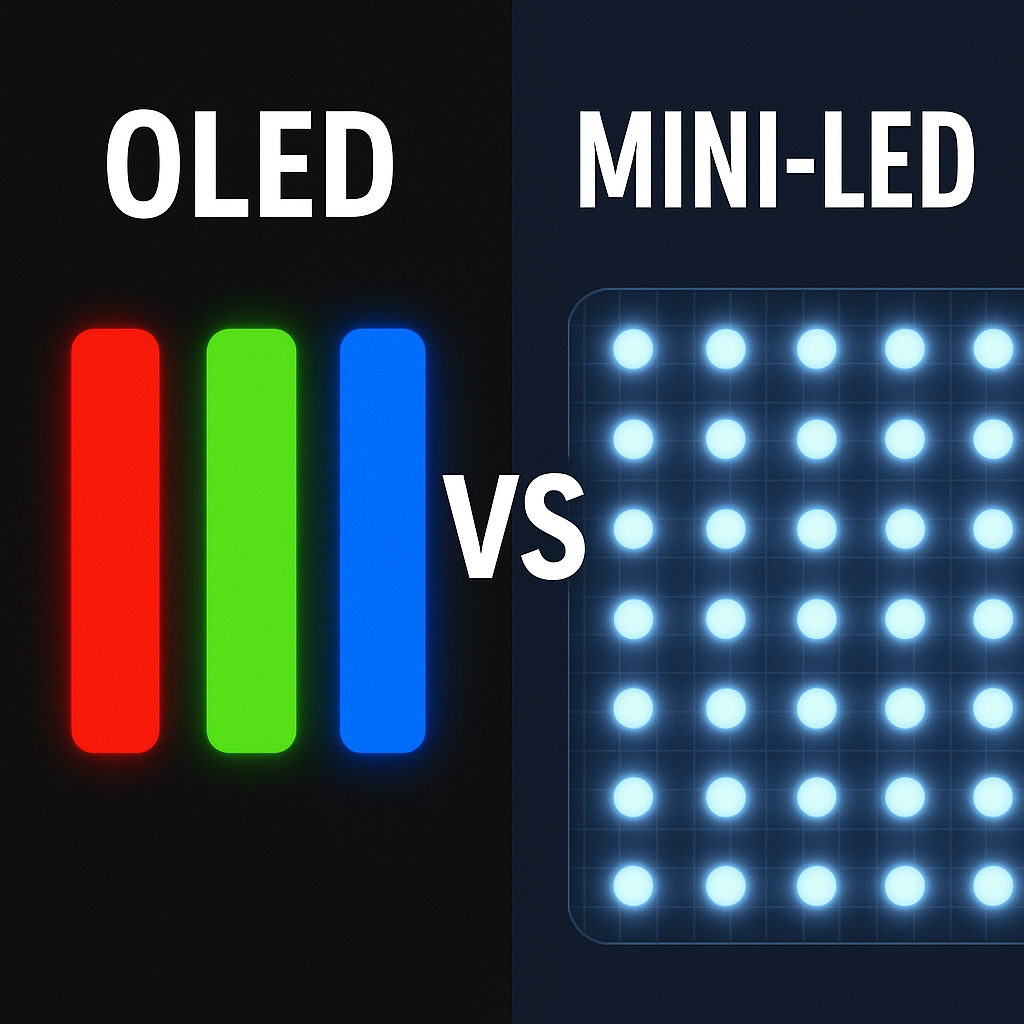📘 Overview
Modern displays have evolved beyond simple LCDs. Today’s top technologies — OLED, Mini-LED, IPS LCD, VA, QLED, and QD-OLED — balance trade-offs in contrast, brightness, color accuracy, and power efficiency.
This report explains how each technology works, their strengths, and which is best for TVs, monitors, and mobile devices.
🧩 1. OLED (Organic Light Emitting Diode)
Working Principle:
OLED pixels emit their own light when an electric current passes through organic emissive layers (carbon-based). No backlight is required.
Advantages
- Perfect black levels — each pixel can turn off completely.
- Extremely high contrast ratio.
- Fast response times (sub-millisecond).
- Thin, flexible panels possible.
Limitations
- Lower peak brightness compared to Mini-LED.
- Risk of burn-in or image retention.
- Higher manufacturing cost.
Applications:
High-end TVs (LG, Sony), professional monitors, smartphones (Samsung Galaxy, iPhone).
Reference:
LG Display — OLED Technology Overview
💡 2. Mini-LED (Advanced LCD Backlight)
Working Principle:
Mini-LED uses thousands of tiny LEDs as a backlight behind an LCD layer. Local dimming zones allow more precise brightness control.
Advantages
- Very high peak brightness (up to 3000 nits).
- Excellent HDR performance.
- No burn-in issues.
- Longer lifespan and cost-effective compared to OLED.
Limitations
- Blacks not perfectly black (halo/blooming effect).
- Slightly thicker panel.
- Requires complex backlight control.
Applications:
High-end TVs (Samsung Neo QLED, TCL, Hisense), Apple MacBook Pro, gaming monitors.

Reference:
Apple — Mini-LED Technology in Pro Display XDR
🧭 3. IPS LCD (In-Plane Switching)
Working Principle:
In IPS panels, liquid crystals align horizontally to the glass substrate, improving color accuracy and viewing angles.
Advantages
- Excellent color accuracy.
- Wide viewing angles (~178°).
- Affordable and mature technology.
Limitations
- Limited contrast (~1000:1).
- Needs constant backlight (lower efficiency).
- Slower response than OLED or VA.
Applications:
Monitors, photo-editing displays, budget TVs.

Reference:
Panasonic IPS Alpha Technology
⚙️ 4. VA (Vertical Alignment) Panels
Working Principle:
Liquid crystals align vertically when inactive, blocking light more effectively in dark scenes.
Advantages
- High contrast (3000–6000:1).
- Deeper blacks than IPS.
- Good color reproduction.
Limitations
- Narrower viewing angles.
- Slower transitions (motion blur).
Applications:
Mid-range TVs, contrast-focused monitors.

Reference:
Sony BRAVIA Display Technology
🌈 5. QLED (Quantum Dot Enhanced LCD)
Working Principle:
Quantum Dots convert blue LED light into pure red and green, improving color saturation in LCDs.
Advantages
- Wide color gamut (up to 100% DCI-P3).
- Bright, vivid visuals.
- No burn-in risk.
Limitations
- Still requires backlight.
- Limited black level vs OLED.
Applications:
Samsung QLED TVs, gaming displays.
Reference:
Samsung Display — Quantum Dot Technology
🧬 6. QD-OLED (Quantum Dot OLED)
Working Principle:
QD-OLED (Quantum Dot Organic Light Emitting Diode) uses blue OLED emitters with a Quantum Dot layer that converts some of the blue light into red and green.
This merges the emissive power of OLED with the color purity of Quantum Dots.
Advantages
- Higher brightness than traditional OLED (up to 2000 nits).
- Wider color gamut (>100% DCI-P3, near Rec. 2020).
- Perfect blacks and high contrast.
- Improved efficiency and longer lifespan.
Limitations
- High manufacturing cost.
- Requires multiple blue OLED layers (higher power draw).
- Limited product availability.
Applications:
Premium TVs (Samsung S95C, Sony A95L) and high-end monitors (Dell Alienware QD-OLED).

⚖️ 7. Summary Comparison Table
| Feature | OLED | Mini-LED | IPS LCD | VA LCD | QLED | QD-OLED |
|---|---|---|---|---|---|---|
| Light Source | Self-emissive | LED backlight | LED backlight | LED backlight | LED + Quantum Dots | Self-emissive (OLED + QD) |
| Contrast Ratio | ∞:1 | 10,000:1 | 1,000:1 | 4,000:1 | 5,000:1 | ∞:1 |
| Peak Brightness | 800–1500 nits | 1500–3000 nits | 400–600 nits | 600–800 nits | 1000–2000 nits | 1500–2000 nits |
| Color Gamut | 99% DCI-P3 | 95% DCI-P3 | 90% DCI-P3 | 90% DCI-P3 | 100% DCI-P3 | 100% DCI-P3 + Rec. 2020 |
| Burn-in Risk | Yes | No | No | No | No | Low |
| Viewing Angle | Excellent | Good | Excellent | Fair | Good | Excellent |
| Cost | $$$ | $$ | $ | $ | $$ | $$$$ |
🧠 8. Future Trends
- Micro-LED is emerging as the ultimate display: inorganic, self-emissive, and ultra-bright.
- QD-OLED is rapidly improving in lifespan and brightness.
- Tandem OLED and MLA (Micro Lens Array) tech push OLED above 2000 nits.
- Hybrid OLED (Inkjet printed) may reduce production costs by 2027.
Reference:
Display Week SID 2025 Technical Papers
📸 Recommended Image (Hero)

